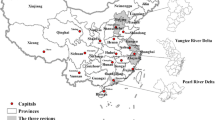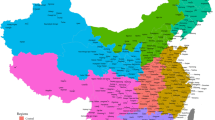Abstract
Accompanying China’s rapid industrialization, a vast area of the country, particularly the Beijing–Tianjin–Hebei (BTH) region, has significantly experienced concerning levels of air pollution over the past decade. Exposure to severe particulate matter (PM), \(PM_{2.5}\) in particular, it raises a crucial public health concern, but quantifying \(PM_{2.5}\) accurately across large geographic areas and across time poses a great challenge. To investigate \(PM_{2.5}\) concentration in the BTH region, we utilize a spatio-temporal mixed effects model that includes geographic information system-based time-invariant spatial variables and time-varying meteorological covariates. Our kriging results find that \(PM_{2.5}\) concentration is hazardous in the North China Plain (NCP), where major iron, steel, and cement industries are located. More importantly, our analysis of the impact of wind finds that the severity of air pollution highly depends on the direction of the wind. That is, a northerly wind can considerably reduce the level of \(PM_{2.5}\) in the NCP, while a southerly wind generally does not alleviate air pollution and sometimes even increases it. Using prediction error as a proxy for the level of local emissions, we find that Shijiazhuang and Tangshan produce the most significant local emissions, which coincides with a heavier industry in these two cities. During the winter heating period, we find that the two densely populated cities of Beijing and Tianjin have dramatic increases in local emissions because of the massive coal consumption during this period.











Similar content being viewed by others
References
Alduchov OA, Eskridge RE (1996) Improved magnus form approximation of saturation vapor pressure. J Appl Meteorol 35(4):601–609
Andrews D (1991) Heteroskedasticity and autocorrelation consistent covariant matrix estimation. Econometrica 59(3):817–858
Calculli C, Fassò A, Finazzi F, Pollice A, Turnone A (2015) Maximum likelihood estimation of the multivariate hidden dynamic geostatistical model with application to air quality in apulia, italy. Environmetrics 26(6):406–417
Chen L, Guo B, Huang J, He J, Wang H, Zhang S, Chen SX (2018) Assessing air-quality in beijing-tianjin-hebei region: The method and mixed tales of pm2. 5 and o3. Atmos Environ 193:290–301
Cressie N (2006) Block kriging for lognormal spatial processes. Math Geol 38(4):413–443
Cressie N (2015) Statistics for spatial data. Wiley, New York
Cressie N, Wikle CK (2015) Statistics for spatio-temporal data. Wiley, New York
De Oliveira V (2006) On optimal point and block prediction in log-gaussian random fields. Scand J Stat 33(3):523–540
Donaldson K, Li X, MacNee W (1998) Ultrafine (nanometre) particle mediated lung injury. J Aerosol Sci 29(5–6):553–560
Fanshawe TR, Diggle PJ, Rushton S, Sanderson R, Lurz P, Glinianaia SV, Pearce MS, Parker L, Charlton M, Pless-Mulloli T (2008) Modelling spatio-temporal variation in exposure to particulate matter: a two-stage approach. Environmetrics 19(6):549–566
Fassò A (2013) Statistical assessment of air quality interventions. Stoch Environ Res Risk Assess 27(7):1651–1660
Fassò A, Finazzi F, Ndongo F (2016) European population exposure to airborne pollutants based on a multivariate spatio-temporal model. J Agric Biol Environ Stat 21(3):492–511
Finazzi F, Fassò A (2014) D-stem: a software for the analysis and mapping of environmental space-time variables. J Stat Softw 62(1):1–29
Li H, Zhang Q, Zhang Q, Chen C, Wang L, Wei Z, Zhou S, Parworth C, Zheng B, Canonaco F et al (2017) Wintertime aerosol chemistry and haze evolution in an extremely polluted city of the north china plain: significant contribution from coal and biomass combustion. Atmos Chem Phys 17(7):4751–4768
Liang X, Zou T, Guo B, Li S, Zhang H, Zhang S, Huang H, Chen SX (2015) Assessing beijing’s pm2. 5 pollution: severity, weather impact, APEC and winter heating. In: Proc. R. Soc. A, vol 471, p 20150257. The Royal Society
Liang X, Li S, Zhang S, Huang H, Chen SX (2016) Pm2. 5 data reliability, consistency, and air quality assessment in five chinese cities. J Geophys Res 121 (17)
McMillan NJ, Holland DM, Morara M, Feng J (2010) Combining numerical model output and particulate data using bayesian space-time modeling. Environmetrics 21(1):48–65
Newey WK, West KD (1986) A simple, positive semi-definite, heteroskedasticity and autocorrelationconsistent covariance matrix
Nguyen H, Cressie N, Braverman A (2012) Spatial statistical data fusion for remote sensing applications. J Am Stat Assoc 107(499):1004–1018
Paciorek CJ, Yanosky JD, Puett RC, Laden F, Suh HH (2009) Practical large-scale spatio-temporal modeling of particulate matter concentrations. Ann Appl Stat 370–397
Pope CA, Ezzati M, Dockery DW (2009) Fine-particulate air pollution and life expectancy in the united states. N Engl J Med 360(4):376–386
Sahu SK, Gelfand AE, Holland DM (2006) Spatio-temporal modeling of fine particulate matter. J Agric Biol Environ Stat 11(1):61–86
Sampson PD, Szpiro AA, Sheppard L, Lindström J, Kaufman JD (2011) Pragmatic estimation of a spatio-temporal air quality model with irregular monitoring data. Atmos Environ 45(36):6593–6606
Shaddick G, Yan H, Vienneau D (2013) A bayesian hierarchical model for assessing the impact of human activity on nitrogen dioxide concentrations in Europe. Environ Ecol Stat 20(4):553–570
Wang L, Wei Z, Yang J, Zhang Y, Zhang F, Su J, Meng C, Zhang Q (2013) The 2013 severe haze over the southern Hebei, China: model evaluation, source apportionment, and policy implications. Atmos Chem Phys Discuss 13(11)
Wang L, Zhang N, Liu Z, Sun Y, Ji D, Wang Y (2014) The influence of climate factors, meteorological conditions, and boundary-layer structure on severe haze pollution in the Beijing-Tianjin-Hebei region during January 2013. Adv Meteorol
Yin Q, Wang J, Hu M, Wong H (2016) Estimation of daily pm2. 5 concentration and its relationship with meteorological conditions in Beijing. J Environ Sci 48:161–168
Zhang S, Guo B, Dong A, He J, Xu Z, Chen SX (2017). In: In Proc R, Soc A (eds) Cautionary tales on air-quality improvement in Beijing, vol 473, p 20170457. The Royal Society
Zhao H, Che H, Zhang X, Ma Y, Wang Y, Wang H, Wang Y (2013a) Characteristics of visibility and particulate matter (pm) in an urban area of northeast china. Atmos Pollut Res 4(4):427–434
Zhao X, Zhao P, Xu J, Meng W, Pu W, Dong F, He D, Shi Q (2013b) Analysis of a winter regional haze event and its formation mechanism in the north china plain. Atmos Chem Phys 13(11):5685–5696
Acknowledgements
This research was undertaken with the assistance of data resources provided by Professor Song Xi Chen’s research group based at Peking University (https://www.songxichen.com).
Author information
Authors and Affiliations
Corresponding author
Additional information
Handling Editor: Pierre R. L. Dutilleul
Supplementary Information
Below is the link to the electronic supplementary material.
Rights and permissions
About this article
Cite this article
Chang, L., Zou, T. Spatio-temporal analysis of air pollution in North China Plain. Environ Ecol Stat 29, 271–293 (2022). https://doi.org/10.1007/s10651-021-00521-4
Received:
Revised:
Accepted:
Published:
Issue Date:
DOI: https://doi.org/10.1007/s10651-021-00521-4




